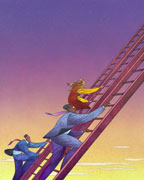Creativity is good — and more critical than ever in business. So why do so many once-creative companies get bogged down over time, with continuous innovation the exception and not the norm? Wharton management professor Jennifer Mueller and colleagues from Cornell University and the Indian School of Business have gained critical insight into why.
In a paper titled, “Recognizing Creative Leadership: Can Creative Idea Expression Negatively Relate to Perceptions of Leadership Potential?” to be published in the March 2011 issue of the Journal of Experimental Social Psychology, Mueller and co-authors Jack A. Goncalo of Cornell and Dishan Kamdar of ISB undertook three studies to examine how creative people were viewed by colleagues. The troubling finding: Those individuals who expressed more creative ideas were viewed as having less, not more, leadership potential. The exception, they found, was when people were specifically told to focus on charismatic leaders. In that case, creative types fared better. But the bottom line is that, in most cases, being creative seems to put people at a disadvantage for climbing the corporate ladder. “It is not easy to select creative leaders,” says Mueller. “It takes more time and effort to recognize a creative leader than we might have previously thought.”
That reality should be of concern to those who sit in corporate boardrooms around the globe. In a recent survey of 1,500 CEOs by IBM’s Institute for Business Value, creativity was named the single most important attribute for success in leading a large corporation in the future. That finding is hardly surprising to Mueller. “There is research that shows that those who have their own creative ideas are better leaders,” she notes. “Those individuals know how to recognize good ideas, are open to them and know how to get creative ideas through [the organization]. Selecting creative leaders is the critical challenge organizations face.”
But understanding the need for creativity within a large company is not the same as actually fostering it. Indeed, Mueller’s work shows that those who think outside the box may be penalized for it. In the first study included in the paper, Mueller and her colleagues examined this trend at a division of a large multinational refinery in Central India. A total of 346 employees took part in the study, with 291 of them being evaluated for leadership potential and 55 employees making those evaluations. The raters were asked to fill out questionnaires on these 291 individuals, grading them on both the degree to which they came up with new, useful ideas and the extent to which they were likely to “become an effective leader” and “advance to a leadership position.” In analyzing the data, Mueller and her team controlled for the likelihood that some creative types were simply not interested in moving up the management ranks.
The group found a significant correlation between being creative and being seen as poor management material. “By definition, people will say creativity is positive,” Mueller states. “It is almost impossible to get people to say they don’t want creativity. But when someone actually voices a creative idea, there is a response of, ‘Wow — What is that?’ This issue really comes to life at the moment the idea is voiced. There is discomfort when people encounter creativity.”
‘Idea Pitcher’ vs. Idea Evaluator
That finding was borne out in a second study. Here, Mueller and her colleagues studied 194 students enrolled in a large university in the northeastern United States. Half the group was put into the role of “idea pitcher,” while the other half had the job of evaluating those ideas. The challenge was to come up with an idea for how an airline might generate more revenue from passengers. Among the idea pitchers, half were told to come up with a creative solution to that problem, which was defined as one that was both novel and useful. The other half were told to come up with an idea that was simply useful. Students had 10 minutes to pitch the evaluators on their ideas, and then the evaluators rated them on several factors including how creative the idea was and what sort of leadership potential each one had.
Again, those who came up with creative ideas were viewed to have significantly less leadership potential than those who simply came up with a useful solution. To be sure that this wasn’t just a personality issue — that somehow the creative people were coming across as less likable — Mueller’s team also asked questions about how competent and warm the idea pitchers were. That revealed that both groups were viewed as being equally warm and competent. So the problem was simply the presentation of a clever idea, not a perceived personality defect.
According to Mueller, these findings are consistent with how people have traditionally defined business leadership in the past. “The value that leaders have for groups is in creating common goals so the group can achieve something,” Mueller notes. “And goals are better the clearer they are — you don’t want uncertainty. So leaders need to diminish uncertainty and create standards of behavior for everyone in the group. And they create those standards by conforming to them.”
She contrasts that thinking with how people describe a creative person. Other academic literature has found that when people are asked what comes to mind when they think of a creative person, “in addition to ‘visionary’ and ‘charismatic,’ people also use words like ‘quirky,’ ‘unfocused’ [and] ‘nonconformist.’ The fact is people don’t feel just positively about creative individuals — they feel ambivalent about them.”
Of course, Mueller says not every organization fails to promote creative types. Some firms, like IDEO and Apple, are specifically geared toward nurturing creativity and valuing innovation; the value of those qualities is ingrained in their culture, Mueller states, not just something that is given lip service by the top brass. To show this, Mueller and her colleagues performed a third study. In this case, they took a group of 183 students at a large Northeastern university and broke them into two groups. The first group was primed to think about leadership and charisma together by being asked to list five attributes that define a charismatic leader. “When you have the word ‘charismatic’ activated in your mind, you may be thinking more along the lines of creativity,” Mueller notes.
After listing those attributes, the group was given a story about a person voicing an idea, again for how an airline could generate more revenue from passengers. Half the group were given the story with the individual putting forth a useful, but not novel, idea for solving that problem while the other half were given the story with the person coming up with a creative and useful suggestion (in this case, it was to charge for online gaming during the flight). They all were asked to rate, on leadership potential, the person who came up with the idea. In this case, the group exposed to the creative idea rated that person as having higher leadership potential than the group whose story contained someone putting forth just a practical idea.
But what if people were not thinking specifically about charismatic leaders? The second group out of that same pool of 183 students was not primed to think about charisma and leadership together. They were simply asked to list attributes of a leader; the word ‘charismatic’ was not mentioned. Then these students were broken into two groups and put through the same exercise of rating either a creative idea or just a useful one. In this case, the results were the opposite of the first group studied — they ranked the leadership potential of the person who had a creative idea below that of the individual who simply came up with a useful idea.
Debunking Stereotypes
According to Mueller, this study points to the conflicting feelings that people often have around truly creative thinkers. In the paper, she and her co-authors write that leaders who are the most original may be overlooked “in favor of selecting leaders who would preserve the status quo by sticking with feasible, but relatively unoriginal solutions.” They suggest that the reality created by this bias could explain why the IBM survey of leaders found that many expressed doubt or a lack of confidence in their ability to take charge in times of complexity. Those leaders were ostensibly promoted “based on this prototypical perception of leadership and now find themselves in a world that has vastly changed, one that requires much more creative responses and thinking.”
That means that companies need to “debunk the stereotypes” against creative people, Mueller says. “The fact is, some people are selected for a leadership [track], while others are not. So companies need to think about this issue, and their performance appraisal systems should be changed accordingly. Managers need help in understanding what stereotypes they might have in their minds and how to overcome them.”
The key is how companies view the traits associated with creativity. “There are some cultures where it is less of a problem than others,” Mueller notes. “The question is, ‘How do you think about descriptions like ‘quirky’ and ‘unfocused’? If those traits are viewed only negatively, then you have more of a problem.” It is important for firms with that view to examine these biases because “many companies want to be creative and they just don’t know what they are doing wrong. Diagnosing that you are one of those companies is the first step in solving it.”
Of course, Mueller is not arguing that every quirky, creative whiz is suited for a corner office. “Leaders require multiple skills, and creativity is just one of them,” she says. “Some creative people don’t have all those skills. But the challenge is to recognize those who do.”



